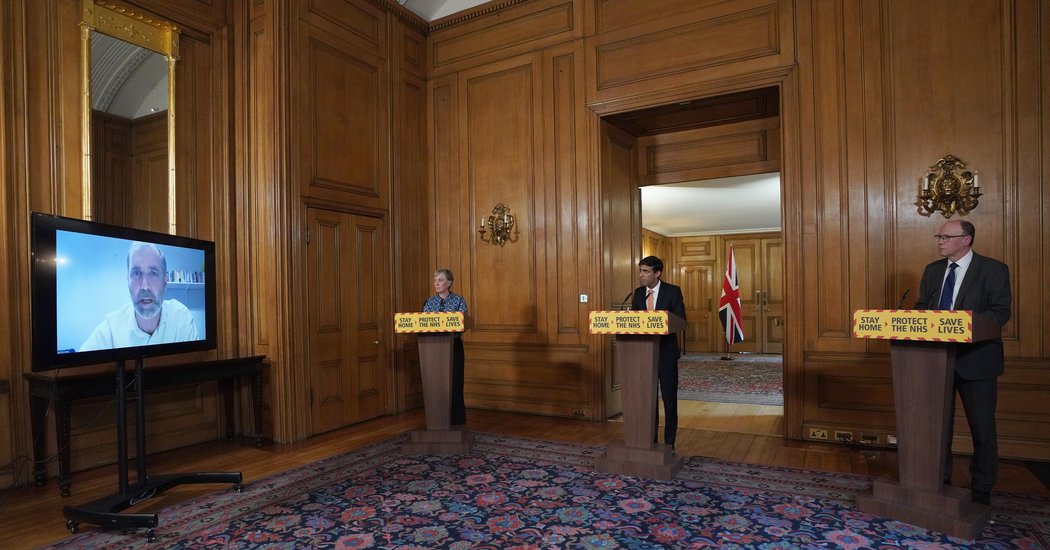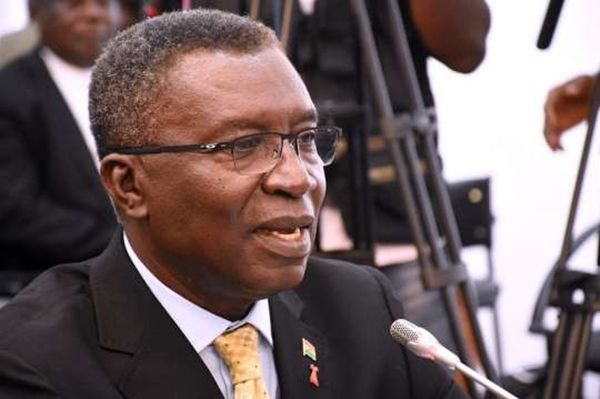[ad_1]
LONDON — Each evening at the stroke of 5, a British cabinet minister and two expert advisers walk into a clubby, wood-paneled room at 10 Downing Street and take their places behind three socially distanced lecterns.
The room is empty but for a large screen, which flickers with the images of journalists, most of them at home, who politely pepper the officials with questions about Britain’s response to the coronavirus. The experts show slides with bars and graphs, and the minister briskly ends the proceedings in under an hour.
This is Britain’s answer to the White House’s daily coronavirus briefing — and except for the starting time, Downing Street’s genteel exercise is the antithesis of the fiery, freewheeling spectacle presided over by President Trump across the Atlantic.
At one level, that is surprising. Britain has been hit hard by the pandemic and the government has come under fire for mishandling its response. Prime Minister Boris Johnson initially played down the threat in ways that echoed Mr. Trump, and British papers have published lengthy investigations of his missteps.
But unlike at the White House, the Downing Street briefings have not become an arena for bitter recrimination or dubious science, to say nothing of wild speculation about injecting people with bleach to kill the virus.
For starters, they have not been dominated by a single lightning-rod personality since Mr. Johnson was sidelined last month with his own case of the virus. He turned over the briefing duties to a rotating cast of ministers, who come across as earnest understudies.
So there is none of the gladiatorial combat of Mr. Trump’s clashes with reporters, none of the awkward moments when the leader second-guesses the scientists and no fulsome expressions of praise by subordinates like Vice President Mike Pence. There is instead a sense of dutiful inquiry.
The exchanges are unfailingly cordial — journalists preface follow-up questions with “if I may” — the atmosphere is cool and the conversation periodically veers into the academic, as ministers defer to the scientists to explain issues like whether the transmission rate of the virus has fallen to below one.
For those missing tennis this summer, tuning in to Downing Street is like watching a crisp gentlemen’s match at Wimbledon. The White House briefing is more like a sweaty night of mixed doubles at Flushing Meadows during the U.S. Open.
And yet, for all the cultural differences, there are deeper parallels between the sessions. Both governments are trying to shape the narrative of how they are handling the pandemic. Both are on the defensive. And both are led by populist politicians who bring campaign-style tactics to an unpredictable crisis.
“Johnson and Trump are both much happier in campaign mode than governing mode,” said Alistair Campbell, who as the press secretary for Tony Blair when he was prime minister built a well-oiled P.R. machine.
These days, Mr. Campbell said, he was spending “most of the time watching these wretched briefings,” not just Downing Street and the White House, but also those led by Gov. Andrew Cuomo of New York, whom he praises effusively.
“Trump is clearly using his briefings with a campaign focus, to attack his opponents and galvanize his base,” Mr. Campbell said. “Johnson, less dangerously but just as politically, is using them to give the sense of being vaguely in control.”
His ministers rarely concede that the government should have done anything differently, even though Britain’s soaring death toll puts it on a par with the worst-hit countries in Europe. They deflect questions about why they have tested so few people, or why hospital workers still do not have enough masks.
“We must stick to the plan, and we must continue to be guided by the science,” said Dominic Raab, the foreign secretary, on April 9, while refusing to give details about either. Mr. Johnson has deputized Mr. Raab to take over his duties temporarily, but the understudy has little of his boss’s charisma.
When the questions get uncomfortable, the politicians dodge and weave. On April 10, a reporter asked the health secretary, Matt Hancock, how many health workers had died during the outbreak.
“I think this is a question for you, Ruth,” Mr. Hancock said, tossing it to Ruth May, the nation’s chief nursing officer, who said it would be inappropriate to get into numbers.
Things were a bit looser when Mr. Johnson was at the podium. Early in the crisis, he often appeared with the chief medical officer, Chris Whitty, and the chief scientific adviser, Patrick Vallance. The news media nicknamed the trio “Boris and the boffins” — British slang for science mavens.
On March 3, Mr. Johnson told reporters, who were then still seated in the room, that he had visited patients in a hospital. “I shook hands with everybody, you’ll be pleased to know,” he said, turning to Dr. Vallance for validation.
“Wash your hands,” he replied, with a regretful shake of his head that was reminiscent of how Anthony S. Fauci, head of the National Institute of Allergy and Infectious Diseases, sometimes reacts to Mr. Trump.
Mr. Johnson’s absence has made the briefings less riveting but perhaps more informative, because it encourages reporters to direct questions to the scientists. Some communications analysts said the lack of focus on a single person was a good thing — and one that should be emulated by Mr. Trump.
“The president and the prime minister are catnip for a very frisky press corps,” said Ari Fleischer, who was press secretary to former President George W. Bush. “Without them,” he said, “you’d get different experts and different questions.”
He said Mr. Trump should appear only three times a week, and there are signs the president may take his advice.
But while Mr. Trump and Mr. Johnson are often compared, they are very different, not least in their communications style. Under Mr. Johnson, Downing Street has hammered a single message, centered on Britain’s National Health Service and emblazoned on the lecterns in the briefing room: “Stay Home. Protect the N.H.S. Save Lives.”
Under Mr. Trump, the White House message shifts daily, depending on the whims of the man delivering it.
“These are not sessions that provide clarity,” said Martha Joynt Kumar, an expert on White House communications. “There is more obfuscation than clarity.”
When Mr. Trump’s name comes up, British officials tread gingerly.
On Friday, Jenny Harries, who is a deputy to Dr. Whitty, the chief medical officer, was asked about the president’s reference to disinfectants. “I wouldn’t have a specific message to Donald Trump,” Dr. Harries said with a smile. “I’d have a specific message to anybody who suggested they should be injecting anything into their bodies.”
That message was: Don’t do it.
With moments like that, Downing Street’s briefings remain popular. They draw between 8 million and 9 million viewers on weekdays, well above the usual audience for BBC’s news shows, according to Enders Analysis, a media research firm in London.
“The U.K. conferences are a genuine attempt to brief the nation, even if the poor quality of politicians and journalistic questioning means they don’t always succeed as well as they should,” said Andrew Neil, a prominent BBC host.
“At least the intent is there,” he said. “The White House equivalents are largely platforms for a show-pony president.”



















